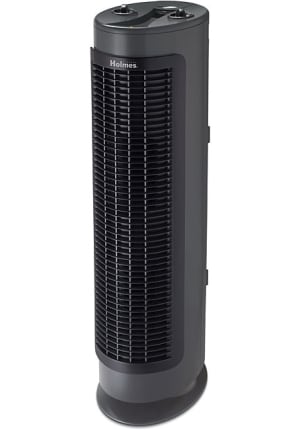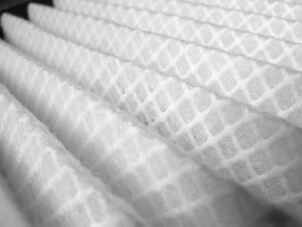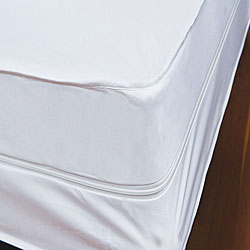
Bed Bugs and Allergies
Tuesday, September 13, 2011
Friday, November 5, 2010
Air Purifiers Buying Guide

- Filtration systems: Filter-based air purifiers are the most popular. In this system, a fan pulls air through a paper or mesh filter. The air filter can be a replaceable model or a permanent, washable model. Washable filters are good for trapping dust, but they don't trap pollen and smaller particulates. Many newer air purifiers incorporate pre-filters that catch larger particles in the air flow to boost the efficiency of the main filter.
- HEPA filters: High-efficiency particulate arresting (HEPA) filters are designed to capture 99.97 percent of airborne particles measuring 0.3 micrometers or larger from the air as they pass through the filter. HEPA filters efficiently remove mold spores, bacteria and dust from the air, making HEPA air purifiers some of the best on the market for people with asthma, allergies or increased susceptibility to illness.
- Activated carbon: Filters are not very good at eliminating odors; therefore, many air purifiers include some form of activated carbon in the design to absorb odors and chemicals. If you have pets or young children at home, look for an air purifier with activated carbon to remove odors from the air.
- Electronic precipitators: The second most common type of air purifier, electronic precipitators draw air through an electrical field and use the electric charge to capture and trap particles on charged metal plates or filters. Some electronic precipitators use a fan to circulate more air at a time. These air cleaners release a small amount of ozone into the air, which is an important consideration if you use the unit in a small room.
- Ionizer purifiers: Both filtered cleaners and electronic precipitators can have built-in ionizing circuitry. Ionizers discharge electrons into the air, forming negative ions by attaching themselves to air molecules. The negative ions attract dust and pollen particles to form larger particles that are more easily trapped by filters. An ionizer helps the air purifier work more efficiently. However, the ionized particles may also attach themselves to upholstery, drapes and carpets, increasing the need for vacuuming.
Thursday, November 4, 2010
How to Change a HEPA Filter

- Unplug it. Turn your air purifier or vacuum cleaner off and unplug the power cord. Turning the system off will protect you from shock and protect the system from damage. Position the air purifier or the vacuum on a drop cloth or old newspaper to catch any debris.
- Remove the filter cover. Some covers easily snap off, while others will require you to remove screws before removing the cover. Air-purifier covers are usually located at the base of the system; vacuum cleaner covers are near the canister or bag.
- Remove the prefilter. Prefilters trap the larger particles and help extend the life of your HEPA filter. Vacuum the prefilter if it's dirty. In addition, you may rinse the prefilter with cool water, if recommended by the manufacturer, and allow it to dry completely before reinstalling it.
- Remove the old HEPA filter. For circular filters, grab the outside cover to pull it out. For flat filters, grab the edge to remove it. Dispose of it carefully to reduce dust and debris.
- Install the new HEPA filter. Make sure the filter is securely mounted.
- Replace the prefilter. Some prefilters have arrows to indicate the position. Use these arrows as a guide.
- Replace the cover. Snap the cover back on or tighten the screws.
HEPA Filter Tips:
- Make sure the replacement filter you purchase is compatible with your air purifier or vacuum cleaner. Installing the wrong filter could make the system ineffective.
- Inspect and vacuum your prefilter every two to three months. Replace the prefilter as necessary. Maintaining your prefilter will extend the life of your HEPA filter.
Allergy Control Pristine Complete Full-size Mattress Encasing
- Protect yourself from dust and allergens with a mattress encasing
- Mattress encasing assists with allergy relief and a provides a healthy sleeping environment
- Physician-recommended
- Soft and breathable 244 thread count microfiber
- Zip closure around your mattress for a layer of protection underneath your sheets
- Proven through scientific testing to protect against bed bugs
- 100-percent polyester microfiber is soft, supple and breathable for full sleeping comfort
- Feels as soft as cotton on your bed
- Oeko-Tex Standard 100-certified to be free of harmful substances that can irritate the skin
- 2.4-micron pore size blocks even ultra-fine dust mite and pet allergens
- Includes an antimicrobial treatment to inhibit mold and mildew
- YKK zipper closure
- Available in white color option
- Machine wash
- Full size: 54 inches x 75 inches
- Available in 9-inch, 12-inch and 15-inch depths
- Depths 12 inches and above feature a clamshell opening for easy placement on the bed
- http://www.overstock.com/Home-Garden/Allergy-Control-Pristine-Complete-Full-size-Mattress-Encasing/4421570/product.html
Monday, November 1, 2010
Friday, October 29, 2010
Allergies Or Asthma - Do You Have Bed Bugs in Your Home?
Are you waking up in the middle of the night itching and have red welts on your body. You might be the victim of bed bug infestation. You can have large welts that fade away in a few days. The following are symptoms:
1. Itchiness while sleeping.
2. Localized swelling of the areas of bites.
3. Blisters around the bites.
4. Blood stains on the sheets where you sleep.
5. Dark spots or stains on the mattress.
The effects of these bites on people can vary from person to person. Typical symptoms are welts and swelling that are more itchy and longer-lasting than mosquito bites. Some people, can have little or no reaction to these bites. Everyone is different.
The first thing you need to do is a visual inspection in your area plus any adjoining areas. It is important to know the extent of the Bed Bug infestation. It is important to know how far this infestation has moved. You need to checks beds, bedding, baseboard/carpet edges, furniture such as nightstands and dressers, upholstered furniture such as couches and chairs, walls and ceilings, clothing, and appliances. They can hide in all these area.
Everyone always asks this question: "What Causes This To Happen?" Bed Bugs will likely start out in a hotel you stayed at recently. They will hide in your clothing, bedding and luggage that you bring home with you. It is no ones fault, they just move to areas where they can feed on humans or animals. They subsist on blood.
You can help stop them by doing the following:
1. Wash all bedding using hot water.
2. Clean the entire area surfaces thoroughly
3. Encase the mattress and box springs in a mattress encasement.
4. If they are under the carpet, the odds are you will have to replace the carpet. You can then thoroughly clean the area under the carpeted area.
5. Check your shoes.
If the problem is out of control, it is important that you call a professional pest control company. They will take care of the problem after a careful examination to see the extent of bed bug infestation.
1. Itchiness while sleeping.
2. Localized swelling of the areas of bites.
3. Blisters around the bites.
4. Blood stains on the sheets where you sleep.
5. Dark spots or stains on the mattress.
The effects of these bites on people can vary from person to person. Typical symptoms are welts and swelling that are more itchy and longer-lasting than mosquito bites. Some people, can have little or no reaction to these bites. Everyone is different.
The first thing you need to do is a visual inspection in your area plus any adjoining areas. It is important to know the extent of the Bed Bug infestation. It is important to know how far this infestation has moved. You need to checks beds, bedding, baseboard/carpet edges, furniture such as nightstands and dressers, upholstered furniture such as couches and chairs, walls and ceilings, clothing, and appliances. They can hide in all these area.
Everyone always asks this question: "What Causes This To Happen?" Bed Bugs will likely start out in a hotel you stayed at recently. They will hide in your clothing, bedding and luggage that you bring home with you. It is no ones fault, they just move to areas where they can feed on humans or animals. They subsist on blood.
You can help stop them by doing the following:
1. Wash all bedding using hot water.
2. Clean the entire area surfaces thoroughly
3. Encase the mattress and box springs in a mattress encasement.
4. If they are under the carpet, the odds are you will have to replace the carpet. You can then thoroughly clean the area under the carpeted area.
5. Check your shoes.
If the problem is out of control, it is important that you call a professional pest control company. They will take care of the problem after a careful examination to see the extent of bed bug infestation.
If you have any questions, feel free to call us or visit our website. To learn more about your money and credit tips, visit our website at http://www.bedbugs23.com or http://www.debt23.com. Ron Lovell is available as a professional speaker to help educate your community or group function on the effects of Financial Stability.
Article Source: http://EzineArticles.com/?expert=Ron_Lovell
Thursday, October 28, 2010
Myths of bed bugs debunked By Sarah Dallof
The mere thought of bed bugs can make your skin crawl, and a recent resurgence of the tiny pests across the country has everyone bugged. But do bed bugs only live in your bed? And can they hitch a ride on your clothing? We're debunking some of the myths about bed bugs and what you really need to do to get rid of them.
First of all, though they're name suggests bed bugs live only in beds, that's not true. They can live in couches, chairs, basically anywhere where you sit or lay quietly for long periods of time. 
Vacuum the mattress (especially the seams and tufts), box springs, bed frame, baseboards, and any furniture near the bed on a daily basis.
The myths about bed bugs seem to be spreading faster than the bugs themselves. One currently being circulated via e-mail claims the bugs are coming in on clothing and towels from companies outside America.
At first it seems to have some truth to it, afterall several stores in New York city had to close due to infestation, but are the bugs really coming home with you on your brand new outfit? That is mostly false. Diane Keay, environmental health area supervisor, with the Salt Lake Valley Health Department, said, "While it's a possibility, and anything is possible, I don't think it's a likely scenario."
How to get rid of bed bugs:
- De-clutter your home; caulk cracks, and repair wall coverings to eliminate hiding and breeding places
- Vacuum the mattress (especially the seams and tufts), box springs, bed frame, baseboards, and any furniture near the bed on a daily basis. Placing a dust mite resistant mattress cover over the mattress and box springs will make the vacuuming easier (keep on for one year). Empty, change or store the vacuum bag inside another container; vacuuming only removes the bed bugs, it does not kill them.
The e-mail suggests people put all new clothing and linens in the dryer first thing. Does that really kill bed bugs?
"Putting things in a dryer will kill bedbugs and kill their eggs, most insecticides will not kill their eggs, "Keay said.
Fast facts on Bed Bugs
- Do not transmit diseases to people
- May trigger asthma
- Can not fly or jump, but can run fast
- Are large enough to be seen
- Can be transported in personal belongings
- Are often found on thrown out furniture
- Can travel through a building
- Can be difficult to control
- Can be eliminated and prevented
"Be sure the label says it can be used on mattresses," Keay said.
One of the biggest questions is: Are bed bugs only in dirty homes? No they're not.
Keay said, "The level of housekeeping really has nothing to do with whether you are going to get bedbugs or not."
Another precaution you can take is to place a bowl under each leg of your bed, then fill it with a quarter to a half inch of mineral oil. And when traveling, keep your suitcase on the luggage rack as bed bugs have a hard time climbing the metal legs.
E-mail: sdallof@ksl.com
Subscribe to:
Posts (Atom)
